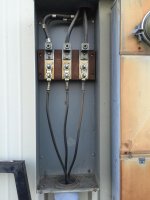Shooter7
Aluminum
- Joined
- Mar 6, 2009
- Location
- Northern CA, USA
I have 400A Service (two 200A Meters and Panels, 208/120 Single Phase) at my building, which should be adequate to power the machinery (via phase converter) that I plan on adding. The incoming PG&E splice box was not locked, so I opened it to verify the incoming line, and was shocked when I found this:

#2 AWG ALCAN, which is good for about 90A, being split to feed (2) 200A Meters! The wire past the split is 3/0 THN, which is about right for 200A.
Here is the PG&E guideline for commercial service entries. See Table 2.
https://www.pge.com/includes/docs/pdfs/mybusiness/customerservice/startstop/newconstruction/greenbook/servicerequirements/063928.pdf
The conduit coming is per the PGE Guideline...at 4", but my incoming conductors are bout 6 sizes too small..even for 200A...let alone 400.
Finally, here is a schematic of the current system, with wire sizes labeled:
Dropbox - Existing SVC.pdf
I am surprised we have not already melted these. What approach should I take to get PGE to correct this, and what is the ballpark cost, given that the conduit currently installed is the correct size. All they would have to do is have the incoming leads pulled and replaced with the proper size. There is a buried vault at the corner of the property, and I hope there is a junction in there with larger feeder cables. The distance from our building to there is only about 60 feet.

#2 AWG ALCAN, which is good for about 90A, being split to feed (2) 200A Meters! The wire past the split is 3/0 THN, which is about right for 200A.
Here is the PG&E guideline for commercial service entries. See Table 2.
https://www.pge.com/includes/docs/pdfs/mybusiness/customerservice/startstop/newconstruction/greenbook/servicerequirements/063928.pdf
The conduit coming is per the PGE Guideline...at 4", but my incoming conductors are bout 6 sizes too small..even for 200A...let alone 400.
Finally, here is a schematic of the current system, with wire sizes labeled:
Dropbox - Existing SVC.pdf
I am surprised we have not already melted these. What approach should I take to get PGE to correct this, and what is the ballpark cost, given that the conduit currently installed is the correct size. All they would have to do is have the incoming leads pulled and replaced with the proper size. There is a buried vault at the corner of the property, and I hope there is a junction in there with larger feeder cables. The distance from our building to there is only about 60 feet.


